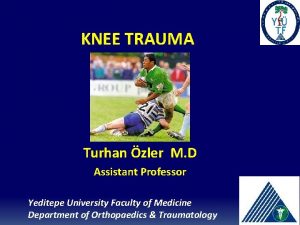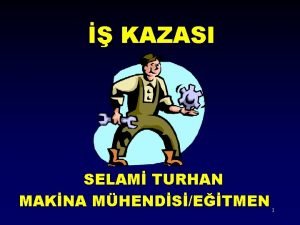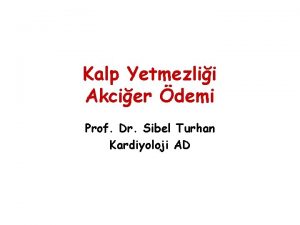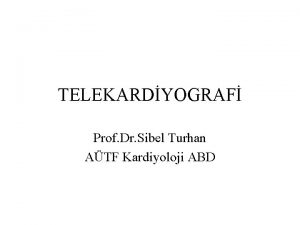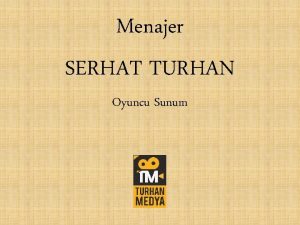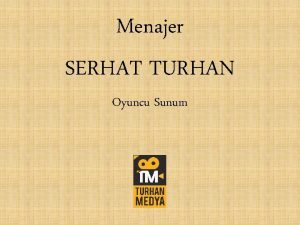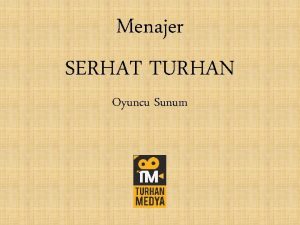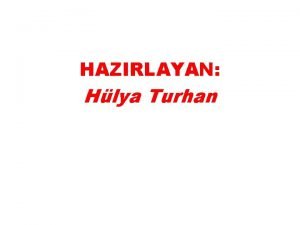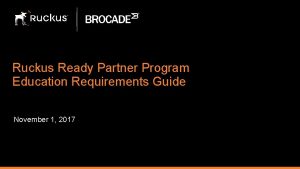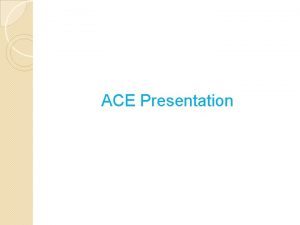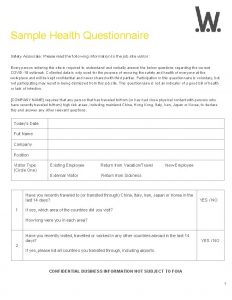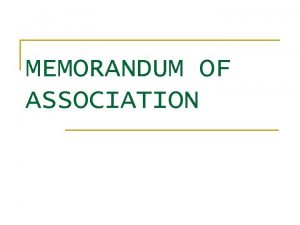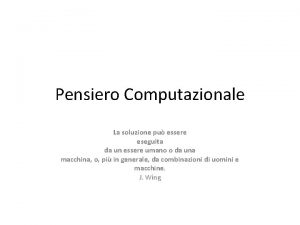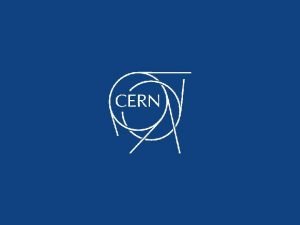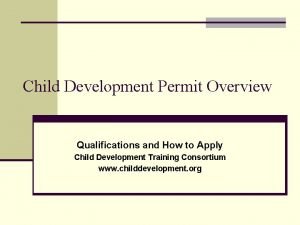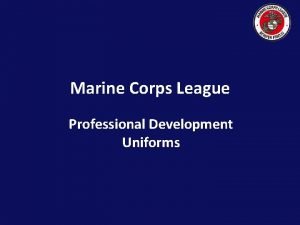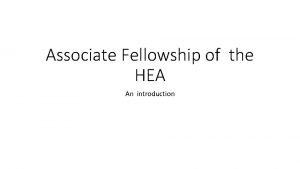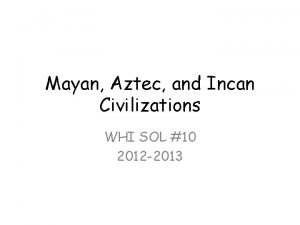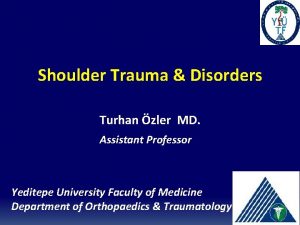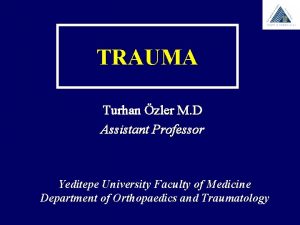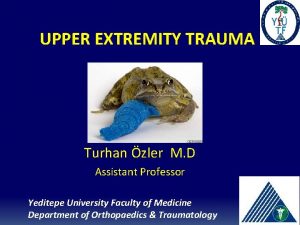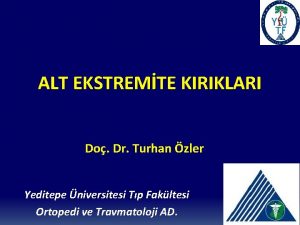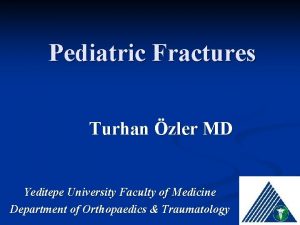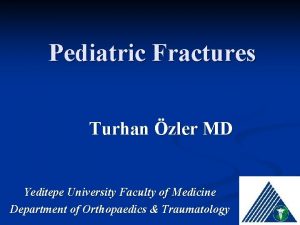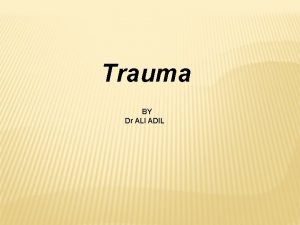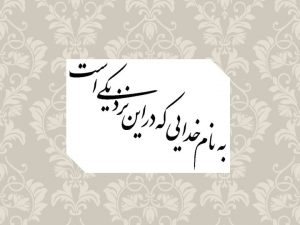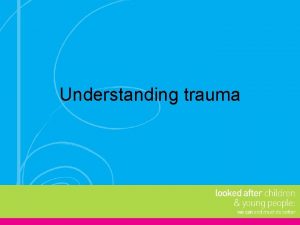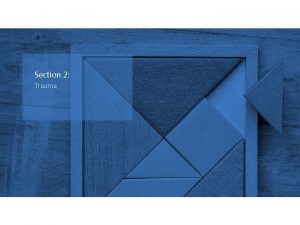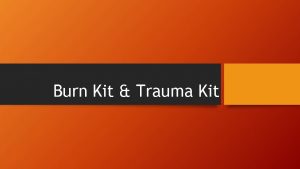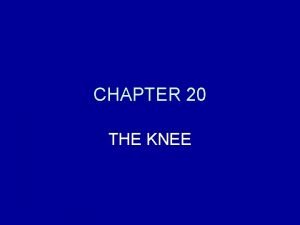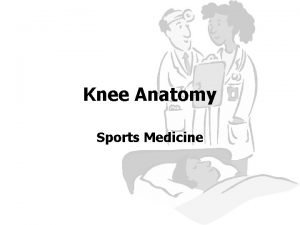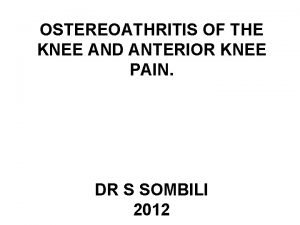KNEE TRAUMA Turhan zler M D Associate Professor











































- Slides: 43

KNEE TRAUMA Turhan Özler M. D Associate Professor Yeditepe University Faculty of Medicine Department of Orthopaedics & Traumatology

Knee Anatomy ü Strong ligament support ü collateral lig: resist valgus and varus loading ü ACL: two bundles, restrict anteriot motion of tibia, valgus, varus, rotation ü PCL: two bundles, restrict posterior motion of the tibia, limits hyper flexion ü Patella: mechanical advantage ü PFJ huge loads when knee is flexed

Knee Anatomy

MRI RIGHT KNEE CORONAL Scan level

MEDIAL - MENISCI ACL PCL MENISCI PATELLA TENDON LATERAL

Knee Injuries ü ACL sprain: more common than ü PCL Mechanism: ü valgus loading and ext tibial rotation (cutting movements) ü hyperextension and internal tibial rotation (landing from jumps/rotate) ü MRI triad: ACL rupture, osseos lession of terminal sulcus, and bone or soft tissue.

SAGITAL MR KNEE (MID JOINT) QUADRICEPS TENDON POSTERIOR CRUCIATE LIGAMENT PATELLAR TENDON ANTERIOR CRUCIATE LIGAMENT Scan level

Knee Injuries üMeniscal tear üLigament tear

Meniscus üAnatomy üMedial üSemicircular(C-shape) üAttached to MCL üLateral üCircular(O-shape) üNo attachment to LCL üFunction üDeepen articular surface üDistribute forces

Meniscal tear üEtiology üTwisting on a planted, flexed knee üFrequency üPossibly most common knee injury in U. S. ü 61 cases per 100, 000 ümale-to-female ratio approximately 2. 5: 1

Imaging meniscal tears üMRI üAbnormal signal intensity within meniscus that extends to an articular surface üAbnormal morphology

Bow-tie rule ünormal meniscal body should be seen as at least two consecutive "bow-ties" on consecutive sagittal images Normal menisci

Common meniscal tears üOblique tear üRadial tear ü“Buckethandle” tear

Oblique (parrot beak) tears Normal Meniscus Oblique tear

Radial tears Coronal image obtained at the level of line B reveals fluid within the large tear

Normal Meniscus Buckethandle tears “Inner rim of meniscus pulls away from meniscal body” Buckethandle tear

Ligaments of the knee ü Anterior Cruciate Ligament ü Prevents anterior translation of tibia ü Posterior Cruciate Ligament Anterior Cruciate Ligament Posterior Cruciate Ligament ü Prevents posterior translation of tibia ü Only 90% size of ACL but is strongest knee ligament ü Medial Collateral Ligament ü Prevents valgus stress ü Lateral Collateral Ligament ü Prevents varus stress Fibular Collateral Ligament Medial Collateral Ligament

Anterior Cruciate Ligament (ACL) Injury üDirect force to the anterior knee, sudden stops or direction change with a planted foot while running or a skier who "catches a tip". üPrevalence higher in females ü 34% associated w/ audible “pop”

Imaging of ACL Tears ü Primary signs ü Plain radiographs usually negative ü MRI üproton density with fat suppression studies in sagittal, coronal and axial planes are commonly used for evaluation ünormal ACL appears as a low signal intensity band with straight, sharply defined margins üacutely injured ACL will have high T 2 signal intensity üincreased T 1 & T 2 signal from associated hemorrhage & edema üsensitivity of 90 -98% & specificity of 100 ü Secondary signs ü anterior drawer sign ü buckled PCL ü uncovering of the posterior horn of the lateral meniscus ü bone contusions in a characteristic location ü specific but not sensitive

Examples ACL tear. Sagittal fat-suppressed T 2 weighted MR image shows discontinuity of the midportion of the anterior cruciate ligament (arrow), which is filled with high signal intensity fluid and hemorrhage Bone contusions associated with an acute ACL tear. Sagittal fat-suppressed T 2 -weighted MR image shows ill-defined areas of bone marrow edema involving the lateral femoral condyle (large arrow) and posterolateral aspect of the tibial plateau (small arrow). These are the characteristic locations of bone contusions associated with an acute ACL injury.

Posterior Cruciate Ligament (PCL) ü Less common than ACL injuries ü occurs when a force is applied to the anterior aspect of the proximal tibia when the knee is flexed or when knee is hyperextended ü Often associated w/ other injuries ü Often minimal to no pain

Imaging of PCL Tears üPlain radiographs usually negative üMRI üproton density with fat suppression studies in sagittal, coronal and axial planes are commonly used for evaluation üperformed in extension so PCL will have sharp bend (genu) üAcute tears most commonly manifest with diffuse widening with increased T 1 and T 2 signal intensity

Examples Fat-suppressed T 2 -weighted MR image shows a discontinuity and gap involving the midportion of the PCL near the Genu (arrow), which is filled with high signal intensity fluid.

Medial Collateral Ligament (MCL) Injury ü Most commonly injured knee ligament ü Commonly associated w/ other injuries of knee (medial meniscus, ACL) ü Contact injuries ü direct valgus load to the knee ü usual mechanism in a complete tear ü Noncontact injuries ü deceleration, cutting, and pivoting motions ü tend to cause partial tears ü Overuse injuries ü have been described in swimmers ü whip-kick technique of the breaststroke ü repetitive valgus loads across the knee

Imaging of MCL Tears üPlain radiography üshould be performed to rule out fractures of the tibial plateau, patella, or distal femur üMRI ücoronal images are more accurate than axial images for grading injuries ümost sensitive signs are fascial edema and loss of demarcation from adjacent fat

Examples MCL tear. Coronal T 2 -weighted MR image shows high-signal intensity along the medial aspect of the knee. The medial collateral ligament shows an undulating course with avulsion off of the femoral attachment (arrow).

Lateral Collateral Ligament (LCL) Injury üMuch less common than MCL injury üCaused by pure varus force üUsually involved in more severe knee injuries üRare enough I couldn’t find a picture

Imaging of LCL Tears üPlain radiographs üshould be obtained to rule out more common injuries üMRI üprocedure of choice for meniscal and ligament evaluation

Examples Coronal T 2 -weighted MR image shows complex signal along the lateral joint margin. The LCL is torn and retracted proximally (arrow).

Knee Injuries ü ACL & Skiers ü backward fall üAnterior drawer mechanism ü Phantom boot üback of skis levers flexed knee into internal rotation ü ACL and females ?

Knee Injuries ü PCL lower incidence of injuries ü half of cause due to direct trauma car accidents ü Sports ü Mechanism ü unrestrained occupant thrown against dashboard ü fall on flexed knee with plantar flexed knee ü force knee flexion ü force knee hyperextension ü quick rotation

Knee injuries ü Unhappy triad: valgus-external rotation ü ACL ü Medial meniscus damage ?

Knee Injuries ü Meniscus: ü weight bearing ü shock absorption ü stabilization ü rotational facilitation ü Full extension ü 45 -50% of the load ü 90 o flexion ü 85% load ü Laterally: 70% of the load 30% AC

Knee Injuries ü Screw home mechanism: ü ü medial rotation at full extension Mechanisn ü flexion or extension and rotation ü tensile loading of medial meniscus ü bucket-handle tear High incidence sports ü soccer, shot put discuss, skiing

Knee injuries üMCL and LCL sprains üForced varus or valgus loading üOveruse übreaststroke kick

Knee injuries ü KEM: knee extensor mechanism ü quads ü PFJ and tendon ü Difference forces in the quad tendon and patellar ligament ü Depend on Knee angle ü Contact force ü Patellar tracking ü Q angle ü Congruence

Knee Injuries üJumper’s Knee üPatellar tendon pain üChondromalacia üdegeneration of the retropatellar AC üTendon Rupture ü>40 years üprevious microtrauma

QUADRACEPS TENDON INJURY Patella tendon injury NORMAL

ANTERIOR CRUCIATE LIGAMENT INJURY Normal

POST OPERATIVE LIGAMENT REPAIR

POSTERIOR CRUCIATE LIGAMENT INJURY normal

MENISCUS NORMAL TORN

 Promotion from assistant to associate professor
Promotion from assistant to associate professor Matt zler
Matt zler Bir kişiye maddeye cihaza işe veya iş yürütümüne
Bir kişiye maddeye cihaza işe veya iş yürütümüne Kontendike
Kontendike Sibel turhan
Sibel turhan Serhat turhan kimdir
Serhat turhan kimdir Serhat turhan
Serhat turhan Serhat turhan
Serhat turhan Hülya turhan
Hülya turhan Cipd experience assessment examples
Cipd experience assessment examples Associate consultant in capgemini
Associate consultant in capgemini Cincinnati state associate degrees
Cincinnati state associate degrees برنامهxx
برنامهxx Rekenhulp tegemoetkoming scholieren
Rekenhulp tegemoetkoming scholieren Ruckus certification training
Ruckus certification training Lonestar nursing requirements
Lonestar nursing requirements Imeche associate membership
Imeche associate membership Michelin alliance associate dealer program
Michelin alliance associate dealer program Laser alignment
Laser alignment Associate program
Associate program Bcs associate membership
Bcs associate membership Safety associate
Safety associate Associate degree rmit
Associate degree rmit What is an associate director
What is an associate director Name something you associate with superman
Name something you associate with superman Memorandum of association
Memorandum of association Incose asep certification
Incose asep certification To associate
To associate Los angeles harbor college nursing
Los angeles harbor college nursing Physician associate lecturer
Physician associate lecturer Associate consultant in capgemini
Associate consultant in capgemini Adobe spark certification
Adobe spark certification Tecniche associate al pensiero computazionale
Tecniche associate al pensiero computazionale Associate warden
Associate warden Harper college international students
Harper college international students Project associate cern
Project associate cern Child development associate teacher permit
Child development associate teacher permit Marine corps league cover regulations
Marine corps league cover regulations Hea associate fellowship
Hea associate fellowship Set-associative mapping advantages disadvantages
Set-associative mapping advantages disadvantages Why critical reading is an active process of discovery
Why critical reading is an active process of discovery Rcog cpd
Rcog cpd Mhp associate partner gehalt
Mhp associate partner gehalt Inca civilization
Inca civilization

